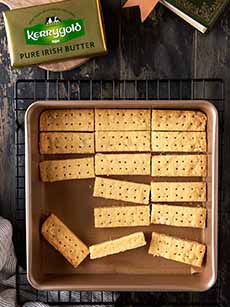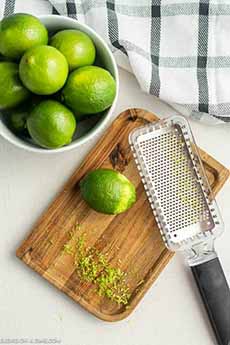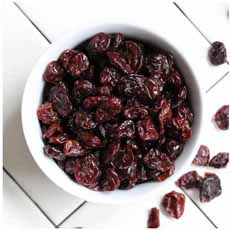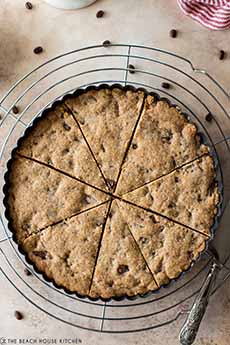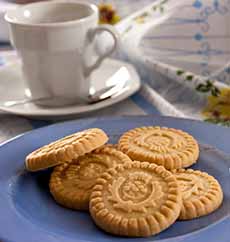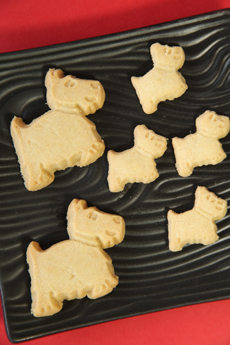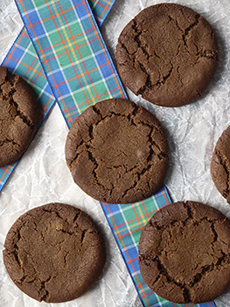Cherry-Lime Shortbread Recipe, National Shortbread Day & All Cookie Holidays
|
January 6th is National Shortbread Day, celebrating Scotland’s great contribution to cookiedom*. The classic Scottish cookie (or biscuit, the term used for cookies in the U.K.) recipe is traditionally one part white sugar, two parts butter, three to four parts plain wheat flour, and a bit of salt—but no leavening†. Over the centuries, the buttery delighted has also been: > The 11 categories of cookies. > The differences between butter cookies, shortbread, and sugar cookies. > The different types of cookies: a photo glossary. > More delicious shortbread cookie recipes are below. > See all 44 of the year’s cookie holidays below. These delightful shortbread cookies (photo #1) are not too sweet and and have a sweet/tart bite from the dried cherries. For a sweeter cookie you can substitute mini chocolate chips. Note that the best, freshest butter will give you the very best cookies. Do not substitute any other fat. Prep time is 25 minutes and bake time is 10 minutes. Ingredients For About 4-1/2 Dozen Cookies 1. CREAM the butter and confectioners’ sugar in a large bowl until blended. Beat in the lime zest and extracts. In another bowl… 2. MIX the flour, baking powder, and salt. Gradually beat the dry mixture into the creamed mixture. Stir in the cherries. 3. DIVIDE the dough in half; shape each half into a 7-inch-long roll. Wrap each roll in plastic and refrigerate overnight. Note that many recipes will say to refrigerate the dough for 3-4 hours or until firm. We have found a longer time yields easier slicing; or you can as easily freeze the dough for 1-2 hours until it is firm enough to slice. 4. PREHEAT the oven to 350°F. Unwrap and cut dough crosswise into 1/4-inch slices with a very sharp, thin knife (there should be 28 quarter-inch slices per 7-inch log. 5. PLACE the slices 2 inches apart on ungreased baking sheets. Bake 9-11 minutes or until the edges are golden brown. Remove from the sheets to wire racks to cool. ________________ *Other Scottish cookies we love: Abernathy biscuits (with caraway seeds), oat cakes, oat and walnut biscuits. †Leavening: Most cookies are made with leavening agents, such as baking soda or baking powder. Leavening agents cause the dough to expand and rise while baking, which affects the cookie’s texture and structure. The two most common leaveners are baking soda and baking powder. Baking soda (sodium bicarbonate) reacts with acidic ingredients (e.g. buttermilk, lemon juice, molasses, vinegar) to release carbon dioxide, which creates air bubbles and a denser cookie with craggy tops. Baking powder causes cookies to rise higher and have a cakier texture. ††Treacle and golden syrup, the difference: Ingredients in British baking, golden syrup is the lightest and mildest form of treacle. It has a more caramelized, buttery flavor and a golden color. “Treacle” is most often used to refer to a darker, richer, and slightly bitter syrup. While there is regular treacle, “black treacle” is the darkest variety of treacle, essentially considered the British equivalent of blackstrap molasses. It’s the most concentrated, intensely flavored type of treacle. Molasses is often compared to treacle. Both are by-products of sugar refining. There’s a slight difference based on processing: Treacle is sweeter, thinner, and slightly less bitter than molasses. Typically, molasses boils for much longer, resulting in a darker, thicker liquid with less sugar. “Black treacle” is most similar to molasses, but can still have slightly different flavor profile depending on the manufacturer and region. ‡Parlies, short for Parliament cakes, are a type of dark-hued shortbread biscuits that look like they might be flavored with cocoa, but intead they get their color from black treacle or molasses (photo #8). They’re seasoned with ground ginger and optional candied ginger, making them warm and spicy with an added hit of mild toffee flavor from the treacle. The history of Parlies: The flavored shortbread, sometimes spelled Parleys, was originally served with Scotch whisky. Today they’re most often served with tea. [Editor’s note: Here’s a recipe. Why not serve them with hot toddies or hot butted rum] [source]. The story goes that in the 18th century, a Mrs. Flockhart, proprietor of a bakeshop located near the Scottish Parliament buildings in Potterow, Edinburgh, created the biscuits and supplied them to the politicians and staff working there. While her first name is lost to history, she is referred to as Luckie Flockhart, Luckie being a Scots term for a respected older woman, particularly one who ran a business. This suggests she was a well-regarded figure in her local community [source: Claude.ai, 2025-01-07). Note that brownies are cookies—bar cookies—and not cake. |
|
|||||||||||||||||||||||||||||||||||||||||||||||||||||||||||
CHECK OUT WHAT’S HAPPENING ON OUR HOME PAGE, THENIBBLE.COM. |
||||||||||||||||||||||||||||||||||||||||||||||||||||||||||||

